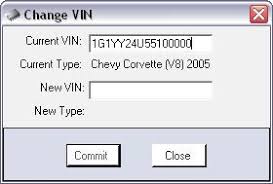Introduction
Ever wondered how vehicles are tracked and identified so precisely? It’s all thanks to the Vehicle Identification Number or VIN. Each car has a unique VIN, like a fingerprint. But what if you need to rewrite this number for legal, diagnostic, or customization reasons? That’s where VIN rewrite tools come in. Let’s explore what these tools are, how they work, and why they might be useful for you.
Understanding VIN (Vehicle Identification Number)
What is a VIN?
A VIN is a 17-character code that uniquely identifies a vehicle. It contains letters and numbers, each segment providing specific information about the car.
Structure of a VIN
The VIN is split into sections, with each part providing specific information:
- The first three characters are the World Manufacturer Identifier (WMI).
- Characters 4 to 9 are the Vehicle Descriptor Section (VDS).
- The last eight characters make up the Vehicle Identifier Section (VIS).
How VIN is Used
VINs are crucial for registering vehicles, tracking recalls, and verifying ownership. They play a significant role in everything from insurance claims to vehicle histories.
Purpose of a VIN Rewrite Tool
Legal Applications
VIN rewrite tools can be used legally in certain circumstances, such as when a vehicle’s VIN plate is damaged and needs replacement.
Diagnostic Uses
Mechanics and vehicle professionals use VIN rewrite tools to diagnose and repair vehicles more effectively by ensuring the correct VIN is recorded in the vehicle’s electronic systems.
Customization and Restoration Projects
For vehicle enthusiasts restoring classic cars or customizing vehicles, rewriting the VIN might be necessary to align with modifications.
How VIN Rewrite Tools Work
Software vs. Hardware Tools
VIN rewrite tools come in both software and hardware forms. Software tools can be installed on a computer, while hardware tools are standalone devices that connect directly to the vehicle.
Process of Rewriting a VIN
Using a VIN rewrite tool typically involves connecting the tool to the vehicle’s OBD-II port, entering the new VIN, and updating the vehicle’s electronic control units (ECUs).
Precautions and Safety Measures
When rewriting a VIN, it’s crucial to follow all instructions carefully to avoid errors. Ensure the vehicle is stationary and in a safe environment.
Legal Considerations
Laws Surrounding VIN Modification
VIN modification is heavily regulated. It’s essential to understand and comply with local laws to avoid serious legal consequences.
Potential Legal Issues and Penalties
Unauthorized VIN modification can lead to fines, vehicle confiscation, and even criminal charges. Always ensure your actions are within the legal framework.
Best Practices for Legal Compliance
Consult with legal experts or vehicle authorities before modifying a VIN. Keep documentation of all changes and the reasons behind them.
Types of VIN Rewrite Tools
OBD-II Port Tools
These tools connect to the vehicle’s OBD-II port, allowing users to rewrite the VIN through the vehicle’s diagnostic system.
Standalone Devices
Standalone devices offer a dedicated solution for rewriting VINs, often providing more features and ease of use.
Professional vs. DIY Tools
Professional tools are generally more expensive but offer greater functionality and support. DIY tools are more affordable and suitable for hobbyists and small projects.
Top VIN Rewrite Tools on the Market
Tool A: Features, Pros, and Cons
Tool A offers comprehensive features like compatibility with multiple vehicle makes and models, a user-friendly interface, and excellent customer support. However, it is pricey.
Tool B: Features, Pros, and Cons
Tool B is budget-friendly and easy to use but may lack the advanced features required by professionals.
Tool C: Features, Pros, and Cons
Tool C strikes a balance between cost and functionality, making it a popular choice among semi-professionals.
Choosing the Right VIN Rewrite Tool
Factors to Consider
Consider compatibility with your vehicle, ease of use, customer support, and cost when choosing a VIN rewrite tool.
User Reviews and Recommendations
Check online reviews and forums to see what other users are saying about the tool. Their experiences can provide valuable insights.
Cost vs. Functionality
While it might be tempting to go for the cheapest option, ensure the tool you choose offers the functionality you need.
Step-by-Step Guide to Using a VIN Rewrite Tool
Preparing Your Vehicle
Before you start, make sure your vehicle is in a safe place, and that you have all the necessary tools and instructions.
Connecting the Tool
Connect the VIN rewrite tool to the vehicle’s OBD-II port. Ensure a stable connection to avoid interruptions.
Rewriting the VIN
Follow the tool’s instructions to enter the new VIN. Double-check the number to ensure accuracy.
Verifying the New VIN
After rewriting the VIN, verify that the new number is correctly recorded in all relevant vehicle systems.
Common Issues and Troubleshooting
Error Messages and Their Meanings
Common error messages might indicate connectivity issues, incorrect VIN format, or software problems. Refer to the tool’s manual for solutions.
Connectivity Problems
Ensure the tool is properly connected to the OBD-II port and that the vehicle’s battery is charged.
Ensuring Accurate Data Entry
Double-check all entries to avoid mistakes. Incorrect VINs can lead to significant issues.
Case Studies
Successful Use of VIN Rewrite Tools
Case studies show how professionals and hobbyists have successfully used VIN rewrite tools for legal VIN replacements and vehicle restorations.
Lessons Learned from Mistakes
Learn from others’ mistakes. Common issues include not following legal guidelines or failing to back up original data.
Future of VIN Rewrite Tools
Technological Advancements
As technology evolves, VIN rewrite tools will become more sophisticated, offering better functionality and ease of use.
Integration with Other Vehicle Diagnostics
Future tools may integrate more seamlessly with other vehicle diagnostics, providing a comprehensive solution for vehicle management.
Potential Market Trends
The demand for more user-friendly and affordable tools is likely to drive future market trends.
Benefits and Drawbacks
Advantages of Using VIN Rewrite Tools
VIN rewrite tools offer precision, efficiency, and flexibility, making them valuable for a variety of applications.
Potential Risks and Limitations
Risks include legal penalties for unauthorized use and potential data entry errors. Ensure proper use to mitigate these risks.
User Testimonials
Real-life Experiences
Users share positive experiences, highlighting how VIN rewrite tools have simplified their work and projects.
Tips and Tricks from Users
Experienced users offer tips such as always backing up original VIN data and double-checking all entries.
Conclusion
VIN rewrite tools are powerful and versatile, offering solutions for legal, diagnostic, and customization needs. As technology advances, these tools will continue to evolve, providing even greater functionality. Whether you’re a professional or a hobbyist, understanding and using VIN rewrite tools responsibly can enhance your vehicle management capabilities.
FAQs
1. Is it legal to use a VIN rewrite tool?
It depends on the context and local laws. Always consult legal experts before modifying a VIN.
2. Can I use a VIN rewrite tool on any vehicle?
Not all tools are compatible with every vehicle. Check the tool’s specifications to ensure compatibility.
3. What should I do if I encounter an error while using a VIN rewrite tool?
Refer to the tool’s manual for troubleshooting tips. Ensure all connections are secure and data is entered correctly.
4. Are there risks involved in rewriting a VIN?
Yes, potential risks include legal issues and data entry errors. Use the tool responsibly and follow all guidelines.
5. How do I choose the best VIN rewrite tool for my needs?
Consider factors like compatibility, functionality, user reviews, and cost. Research and compare options to find the best fit for your needs.










